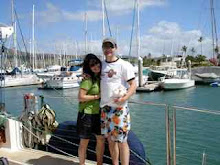
A few weeks ago, our friend Dieter got permission from an acquaintance of his to visit a beach on the southern tip of
We were excited to check out one of the better beaches on the island – so excited, in fact, that we forgot to bring a camera with us, and are indebted to our friend Beth for sharing her shots of the trip with us. The group piled into cars and caravanned south. The pavement ended at the southern tip of the island, and we turned east into the jungle. It must have been comical to watch, three tiny Japanese cars – wheels the size of dinner plates – winding through the jungle on a narrow, bumpy double-track. For our part, we were too busy dodging coconuts and fallen palm fronds to notice anything not directly ahead of us.
After making it all the way to the beach with no visible harm to the car’s undercarriage, we parked and walked to a shelter a few feet from the water. Matt and the boys headed down the beach to do a little bit of exploring while the girls stayed behind to chat and snack on the cookies we had brought along. Dieter brought a machete along for coconut husking; unfortunately the coconuts on the ground were old and dry, and the young ones still on the tree were too high to harvest.  Matt had the bright idea to try and knock the young coconuts down by throwing some of the old coconuts up at them. His efforts were unsuccessful, but at least the soreness in his arm only lasted a couple of days.
Matt had the bright idea to try and knock the young coconuts down by throwing some of the old coconuts up at them. His efforts were unsuccessful, but at least the soreness in his arm only lasted a couple of days.
A short time later, the girls decided that they were going to try and walk out to Bird Island, a small outcrop in the lagoon several hundred yards from shore.
The lagoon is shallow enough to walk the whole way, but the bottom is covered in spots with
sea grass and sharp coral. About a hundred yards from shore, our friend Taylor suddenly bent down and scooped up a sea cucumber from the floor of the lagoon. As soon as she picked it up, however, it began squirting seawater all over her and various members of the group. KC briefly considered taking cover, but decided it wasn’t worth it once she remembered she was already waist deep in the ocean. In the end the poor sea cucumber was returned unharmed to the waters of the lagoon. The effluent, for its part, did prove its worth as a defense mechanism, at least against predators who are easily grossed out. 
In the meantime, those of us who had stayed behind found out that we had come to the wrong place, and were in fact trespassing. The right location was several hundred yards down the beach, but by a stroke of luck the “trespassee” turned out to be the judge for whom KC is clerking. He had decided to come out to the beach for the afternoon with a few friends and invited us to stay. They had a big frozen skipjack tuna with them, which they tossed into the lagoon to thaw for a little while (the fact that the fish did not swim off after defrosting may suggest that investing in cryogenics is a waste of money). While the fish warmed up, they made tongs out of palm branches, and before we knew it there were tuna steaks sizzling on the fire. Feeling bad about the whole trespassing thing, we turned down their offers to share, but watching the process emboldened us to give the Yap Fishing Authority a try later in the week. We’ll write more about our experiences there in a future post.
Once the  This was likewise unsuccessful. Hermit crabs are, as you might expect, not particularly social. And besides, carrying a home around on your back may reduce your incentive to move into prefabricated housing. The crabs abandoned the project quicker than you can say “credit default swap” (where had this motivation been during the race, we wonder?), and it soon fell into disrepair. Last we heard, Minnie and Taylor were muttering something about retention bonuses and demanding a bailout from the FSM government to help them recoup their investment.
This was likewise unsuccessful. Hermit crabs are, as you might expect, not particularly social. And besides, carrying a home around on your back may reduce your incentive to move into prefabricated housing. The crabs abandoned the project quicker than you can say “credit default swap” (where had this motivation been during the race, we wonder?), and it soon fell into disrepair. Last we heard, Minnie and Taylor were muttering something about retention bonuses and demanding a bailout from the FSM government to help them recoup their investment.
A final note – we moved into the house yesterday, and we’ve been busy killing gigantic insects and painting the walls for the last 24 hours. We’ll post pictures of the new pad next week.
































